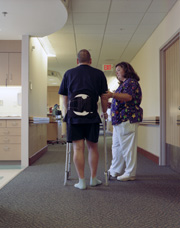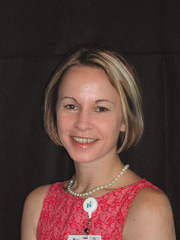The Fast Track Back
From Spine Surgery
By Margot Mohsberg
Few things
can stop humans in their tracks faster than a back and neck injury.
So when an organization offers a spine surgery program that puts
patients back on track toward a speedier, more productive recovery,
news travels fast.
 From the Delmarva Peninsula to southern Maryland and around the
region, Anne Arundel Medical Center's Center for Spine Surgery
is attracting more notice every day as a program with a unique,
family-oriented approach toward getting people back on the road
to recovery faster.
From the Delmarva Peninsula to southern Maryland and around the
region, Anne Arundel Medical Center's Center for Spine Surgery
is attracting more notice every day as a program with a unique,
family-oriented approach toward getting people back on the road
to recovery faster.
Center coordinator Lori Brady says AAMC is one of the first hospitals
in the country to create such a center designated solely to spine
surgery. "Spine centers are fairly new," she says. "But we had
such success with our joint center that we thought we should do
the same thing with our spine program. As a result, we've significantly
reduced the amount of time patients are having to stay in the
hospital after spine surgery. In the spine center, patients and
their families are getting a lot more education and therefore
going home earlier because they know more."
The Center for Spine Surgery, created in 1998 and located on the
fourth floor of the Acute Care Pavilion of AAMC's medical campus,
is an area within the hospital with only one type of patient in
mind: spine surgery patients. All of the health care professionals
in the center specialize exclusively in that area.
"Our neurosurgeons and orthopaedic surgeons are performing the
latest surgical techniques for treating the spine," says Marshall
Steele, M.D., an orthopaedic surgeon and medical director of AAMC's
operating room. "A multidisciplinary conference is held weekly
to plan upcoming surgeries. Computer navigation and new equipment
keeps incisions small and improves accuracy. And our surgeons
are respected throughout the country, standing at the forefront
in the education of other surgeons in the advancements in spine
surgery."
For example, neurosurgeon Brian Sullivan, a member of AAMC's medical
staff and a partner in the Maryland Neurological Institute, recently
received nationwide attention for a new clinical trial. The trial
involves inserting a cervical disc prosthesis into the space between
the patient's neck vertebra. The procedure, performed by only
20 sites nationwide, allows the patient to move his neck afterwards.
Traditional treatment fuses the two vertebra together, leaving
part of the neck permanently immobile.
"It's really the future of cervical spine surgery," says Dr. Sullivan.
"The beauty of this device is that it not only repairs the condition
but also permits the patient to move his neck freely." Interventional
radiologist Tim Eckel, an AAMC medical staff member from Annapolis
Radiology Associates, is performing vertebroplasty, a relatively
new treatment in the United States for vertebral fractures being
performed in only a few hospitals nationwide.
The procedure involves the injection of cement-like material,
as a substitute for bone, into a collapsing vertebral body. The
procedure is performed to reinforce fractured bone, alleviate
chronic back pain and prevent further vertebral collapse, often
caused by illnesses such as osteoporosis. The cement-like material
stabilizes and strengthens the crushed bone.
"Spinal fractures are very common," Dr. Eckel says. "Sometimes
they heal on their own, but when they don't, they can be very
debilitating. Vertebroplasty is a procedure that has an estimated
90 percent success rate for relieving spinal pain. I do lots of
procedures for treating spinal pain, and vertebroplasty is the
most successful."
Orthopaedic surgeon Alessandro Speciale, M.D., also a member of
AAMC's medical staff from the Orthopaedic and Sports Medicine
Center, is currently performing kyphoplasty, which involves using
a balloon to expand two vertebra apart and then filling the space
with the cement-like material similarly used in vertebroplasty.
Just as important to a patient's recovery is his or her mental
health which staff members at the spine center are tending to
just as intently. On Tuesday, Wednesday and Thursday evenings,
the staff hosts a get-together to help encourage camaraderie in
the center. "The patients can talk to each other and know that
they are not alone in their recovery," Brady says.
Perhaps one of the biggest motivation tools at the spine center
is the "back-track board." The board features race cars which
represent each patient. As each patient accomplishes a physical
step forward, the race car is moved forward to show how many feet
the patient has walked.
"Patients can compare their progress to others who have undergone
the same procedure," Brady says. "Not only does it show them where
they want to be, but it inspires them to want to do better. It
creates a fun and friendly rivalry among the patients and an overall
positive environment, which we at the spine center think is the
fastest road to good health." For more information about AAMC's
Center for Spine Surgery, please call 443-481-1650 or call askAAMC
at 443-481-4000 or 800-MD NURSE.
 Margot
Mohsberg is a resident of Eastport and the media relations
associate for Anne Arundel Health System. Margot
Mohsberg is a resident of Eastport and the media relations
associate for Anne Arundel Health System.
|
Back
|

